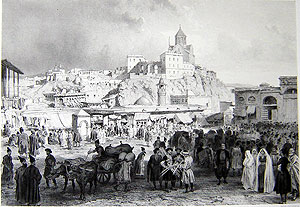Collection / Russian
Graphics
 During 250 years, Russian drawing has passed a quite complicated way of development and has always been characterized by specific and original style and manner. Among the works of Russian painters of the late eighteenth century landscapes and particularly urban scenes were of special importance. This period is represented by three water-colours by Mikhail Ivanov (1748-1823).
During 250 years, Russian drawing has passed a quite complicated way of development and has always been characterized by specific and original style and manner. Among the works of Russian painters of the late eighteenth century landscapes and particularly urban scenes were of special importance. This period is represented by three water-colours by Mikhail Ivanov (1748-1823).
In the nineteenth century Russian painters developed the traditions of the previous century and created drawings in all genres: portrait, still life, landscape etc. From the second half of the century,scenes of everyday life prevailed in the work of many artists. Some idea about the .jpg) achievements of the portrait genre in the early nineteenth century may be formed by Karl Bryullov’s (1799-1852) works painted in water-colour and sepia.The originality and charm of Russian nature are demonstrated in the landscapes of Ivan Shishkin (1832-1898) and Isaak Levitan (1860-1900). The funds of the Museum possess sketches taken from various albums of the famous painter of battle-pieces Vasili Vereschagin (1842-1904). Landscape and genre painting were developed dy the Peredvizhniks: Ilya Repin (1844-1930) and Vladimir Makovsky (1846-1920), whose drawings are to a certain extent connected with the themes of their paintings. Some of their drawings are kept in the Museum.
achievements of the portrait genre in the early nineteenth century may be formed by Karl Bryullov’s (1799-1852) works painted in water-colour and sepia.The originality and charm of Russian nature are demonstrated in the landscapes of Ivan Shishkin (1832-1898) and Isaak Levitan (1860-1900). The funds of the Museum possess sketches taken from various albums of the famous painter of battle-pieces Vasili Vereschagin (1842-1904). Landscape and genre painting were developed dy the Peredvizhniks: Ilya Repin (1844-1930) and Vladimir Makovsky (1846-1920), whose drawings are to a certain extent connected with the themes of their paintings. Some of their drawings are kept in the Museum.
In the late nineteenth century the skilful colourist Vasili Surikov (1848-1916) played a significant role in the development of graphic art. At the turn of the twentieth century the outstanding painters Valentin Serov (1865-1911) and Mikhail Vrubel (1856-1910) created their masterpieces. Serov paid much attention to refining the art of drawing and perfectly mastered its techniques. Vrubel’s work is complicated and full of contradictions. His portraits drawn with pencil and Indian ink are characterized by high skill and profundity of expression; one of them is “The portrait of H. Shamshinyan”.
.jpg) The Russian drawing of the late nineteenth-early twentieth centuries was based on the traditions of the past,but at the same time the graphic artists continued searching for new and original stylistic solutions; hence it is marked by significant achievements connected to the formation of new tendencies and aesthetic principles. Those tendencies and principles are apparent in the works by the group of painters of “Mir Iskusstva” (“World of Art”), namely Alexander Benios (1870-1960), Konstantin Somov (1869-1939), Lev Bakst (1866-1924), Evgeny Lanceray (1875-1946), Mstislav Dobuzhinsky (1875-1957), Boris Kustodiev (1878-1927) and Anna Ostroumova-Lebedeva (1871-1955). They enriched graphic art with new means of expression and their contribution to the development of Soviet art is significant. All the mentioned painters are represented in the Museum collection by one or more works. Among them a special place belongs to Evgeni Lanceray’s (1875-1946) portrait “Arus Voskanyan as Porcia”, a work of high artistic value, which he drew during his visit to Yerevan in 1926.
The Russian drawing of the late nineteenth-early twentieth centuries was based on the traditions of the past,but at the same time the graphic artists continued searching for new and original stylistic solutions; hence it is marked by significant achievements connected to the formation of new tendencies and aesthetic principles. Those tendencies and principles are apparent in the works by the group of painters of “Mir Iskusstva” (“World of Art”), namely Alexander Benios (1870-1960), Konstantin Somov (1869-1939), Lev Bakst (1866-1924), Evgeny Lanceray (1875-1946), Mstislav Dobuzhinsky (1875-1957), Boris Kustodiev (1878-1927) and Anna Ostroumova-Lebedeva (1871-1955). They enriched graphic art with new means of expression and their contribution to the development of Soviet art is significant. All the mentioned painters are represented in the Museum collection by one or more works. Among them a special place belongs to Evgeni Lanceray’s (1875-1946) portrait “Arus Voskanyan as Porcia”, a work of high artistic value, which he drew during his visit to Yerevan in 1926.
.jpg) The water-colours and drawings by the painters of the same period Pyotr Konchalovsky (1876-1956), Ilya Mashkov (1881-1944), Robert Falk (1886-1958), Viktor Borisov-Musatov (1870-1905), Filip Malyavin (1869-1940) and Mikhail Nesterov (1862-1942) are prominent in the Museum collection. Other remarkable possessions of the department of drawing are the works by the famous painters Konstantin Korovin (1861-1939), WassilIy Kandinsky (1866-1944), Kuzma Petrov-Vodkin (1878-1939), Pavel Filonov (1883-1941), and Pavel Kuznetsov (1878-1968).
The water-colours and drawings by the painters of the same period Pyotr Konchalovsky (1876-1956), Ilya Mashkov (1881-1944), Robert Falk (1886-1958), Viktor Borisov-Musatov (1870-1905), Filip Malyavin (1869-1940) and Mikhail Nesterov (1862-1942) are prominent in the Museum collection. Other remarkable possessions of the department of drawing are the works by the famous painters Konstantin Korovin (1861-1939), WassilIy Kandinsky (1866-1944), Kuzma Petrov-Vodkin (1878-1939), Pavel Filonov (1883-1941), and Pavel Kuznetsov (1878-1968).
Easel drawing and book illustration of the mid twentieth century are represented by the works of Pavel Shillingovsky (1881-1942), Zinaida Serebryakova (1884-1967), Orest Vereyskiy (1886-1962), Nikolai Tirsa (1887-1942), Yuri Annenkov (1889-1947), Alexei Kravchenko (1889-1940), Vladimir Lebedev (1891-1967), Konstantin Rudakov (1891-1949), Nikolai Kupreyanov (1894-1939), Ilya Sokolov (1890-1968) and others.